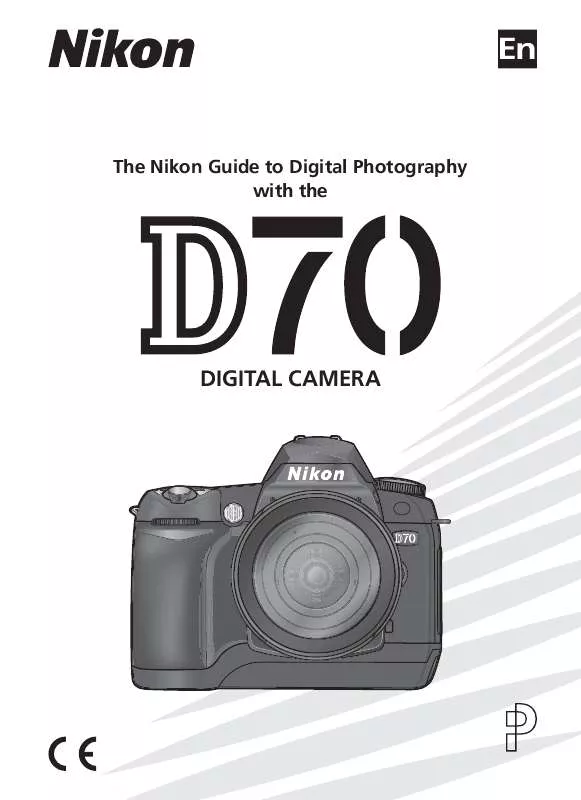Detailed instructions for use are in the User's Guide.
[. . . ] En
The Nikon Guide to Digital Photography with the
DIGITAL CAMERA
Product Documentation
The documentation for this product includes the manuals listed below. Please be sure to read all instructions thoroughly to get the most from your camera. Quick Start Guide The Quick Start Guide takes you through the process of unpacking and setting up your Nikon digital camera, taking your first photographs, and transferring them to your computer. Guide to Digital Photography The Guide to Digital Photography (this manual) provides complete operating instructions for your camera. [. . . ] Changes to sensitivity required to attain optimum exposure or flash level when On is selected for Custom Setting 5 (ISO auto; 142) apply before exposure or flash bracketing is performed.
91
White Balance Bracketing
1 2
Choose WB bracketing for Custom Setting 12 (BKT set; 146). Note that white balance bracketing will not be performed if NEF (Raw) or NEF+JPEG Basic is selected for image quality.
12 BKT set AE & flash AE only Flash only
Taking Photographs--Exposure
?
Pressing the button, rotate the main command dial until is displayed in the control panel. The icon in the control panel and the arrows ( and ) at the ends of the electronic analog exposure display will start to blink.
OK WB bracketing
3
Press the button and rotate the sub-command dial to choose a bracketing program ( 93). Each increment is equivalent to about 10 mired ( 51); if the number of images in the bracketing program exceeds the number of exposures remaining, the bracketing progress indicator ( , , or ) will blink.
Shooting Mode In all modes (including continuous mode), the shutter is released only once each time the shutter-release button is pressed. Each shot is processed to create the number of copies specified in the bracketing program. Turning the Camera Off If the power is turned off during recording, the camera will not power down until all shots in the bracketing sequence have been recorded.
92
4
Compose a photograph, focus, and shoot. Each shot will processed to create the number of copies specified in the bracketing program, and each copy will have a different white balance. Modifications to white balance are added to the white balance adjustment made with white balance fine-tuning ( 50). If the number of shots in the bracketing program exceeds the number of exposures re( ) will be displayed and maining, the bracketing progress indicator and number of exposures remaining will blink. Shooting can begin if a new memory card is inserted. To cancel bracketing, press the button and rotate the main command dial until is no longer displayed in the control panel. The program last in effect will be restored the next time bracketing is activated. Bracketing can also be cancelled by selecting NEF (Raw) or NEF+JPEG Basic for image quality or performing a two-button reset ( 111), although in this case reactivating bracketing will not restore the bracketing program.
Taking Photographs--Exposure
The number of shots, white balance increment (WB), and bracketing order for each of the possible white-balance bracketing programs is shown below.
Control panel display No. of Bracketing shots WB order 3 3 3 2 2 2 ±1 0, 1, +1 ±2 0, 2, +2 ±3 0, 3, +3 +1 +2 +3 0, +1 0, +2 0, +3 Control panel display No. of Bracketing shots WB order 2 2 2 1 2 3 0, 1 0, 2 0, 3
13--BKT Order ( 146) This option can be used to change the bracketing order.
93
Flash Photography
Using the Built-in Speedlight The D70 is equipped with a Guide Number 15/49 Speedlight (ISO 200, m/ ft; Guide Number at ISO 100 is 11/36). When a CPU lens is attached, the built-in Speedlight emits monitor preflashes that are analyzed using throughthe-lens (TTL) technology (i-TTL flash control). The built-in Speedlight can be used not only when natural lighting is inadequate, but also to fill in shadows and backlit subjects or to add a catch light to the subject's eyes. i-TTL Flash Control The following types of flash control are available with CPU lenses:
Flash control Description
Taking Photographs--Flash Photography
i-TTL Balanced Fill-Flash for Digital SLR is selected automatically in all modes except mode M or when spot metering is selected in modes P, S, and A. Speedlight emits series of nearly invisible preflashes (monitor preflashes) immediately before main flash. Preflashes i-TTL Balanced reflected from objects in all areas of frame are picked up by 1, 005Fill-Flash for pixel RGB sensor and are analyzed in combination with information Digital SLR from matrix metering system to adjust flash output for natural balance between main subject and ambient background lighting. If type G or D lens is used, distance information is included when calculating flash output. Standard i-TTL Flash for Digital SLR is activated automatically in mode M and when spot metering is selected in modes P, S, and A. [. . . ] See autofocus; focus mode; manual focus Focus area (focus brackets), 66 Focus lock, 70 Focus mode, 64 Focusing screen, 8 Folders, 126, 156158 Folders, 156158 Format, 160 FV lock, 103104 G Grid display, 144 H Hide image, 129 Highlight display, 116 Histogram, 116 Hue adjustment, 60 I Illuminator. See backlight, control panel Image comment, 163164 Image dust off, 166167 Image files, 41 Image size, 4345 Image quality, 4142 Image review, 144 ISO, 134. See also Sensitivity
Index
206
ISO auto, 142143 i-TTL flash control, 94 J JPEG, 4145 L L. See Image size Language, 163 LCD brightness, 161 Lens, 183185 attaching, 1819 compatible, 183184 CPU, 183184 non-CPU, 183184 type G or D, 183184 Long exp. [. . . ]


 NIKON D70 BROCHURE (568 ko)
NIKON D70 BROCHURE (568 ko)
 NIKON D70 DATASHEET (524 ko)
NIKON D70 DATASHEET (524 ko)
 NIKON D70 QUICK START GUIDE (5323 ko)
NIKON D70 QUICK START GUIDE (5323 ko)
 NIKON D70 ANNEXE 480 BROCHURE (2504 ko)
NIKON D70 ANNEXE 480 BROCHURE (2504 ko)
